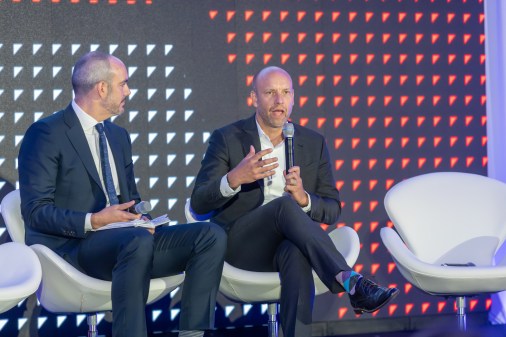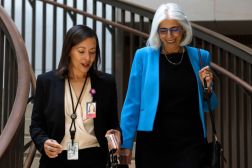How the federal government is using IT to lower costs

The federal government has gotten the message: to rein in the ballooning costs of outdated IT systems, new technologies, methods and services need to be integrated into agencies as soon as possible.
A number of government and industry experts highlighted the ways they are changing their systems during FedScoop’s 8th annual Lowering the Cost of Government with IT Summit Thursday at the Newseum in Washington, D.C. Top IT decision-makers discussed cloud to agile development to workplace culture, describing what it takes to move agencies forward — as well as challenges they must overcome.
“Incorporating cloud into your portfolio is a strategic business decision that will lower your cost from a total cost of ownership perspective … but you know, you need to plan for it,” said Stan Kaczmarczyk, director of GSA’s cloud computing project, during a conversation on cloud.
Panelists identified two concerns agencies face while making the switch: security and agency work culture. John Hale, chief of enterprise applications at the Defense Information Systems Agency, said the Federal Risk and Authorization Management Program is crucial for ensuring security.
“From a DOD perspective, when we look at computing and cloud computing going forward, we are 100 percent dependent on the FedRAMP process,” Hale said. “So all of our commercial cloud providers who want to provide services to the DOD, the very first question we ask them is ‘What level of FedRAMP certification have you achieved?’”
Ashley Mahan, FedRAMP agency evangelist at the General Services Administration, said continuous monitoring and instant response are key to an effective risk management strategy.
“If something goes down in that cloud service provider environment, [a] cloud service provider really has to be upfront and have established communication channels between the cloud service provider and the agency to make sure that that reporting is done within the appropriate time frames,” Mahan said.
Migration to cloud data storage solutions drives so much of the cost-savings discussion, said Treasury Department CIO Sonny Bhagowalia, as it allows for greater administrative flexibility and capabilities at government agencies in the federal, state and municipal levels.
As part of this effort to use IT to cut government costs, Bhagowalia added that shared services also offer an opportunity to enable lines of business and streamline processes across the federal government.
When it comes to workplace culture, the move toward agile development is also driving agencies to think differently while also saving money.
U.S. Citizenship and Immigration Services is using an automated system to help integrate and test code to help agencies make their development process as quick as possible, and in turn, save money.
The automated process takes the code developed by a software engineer, puts it through a review process, merges it with other code, and tests itself for any issues, USCIS CIO Mark Schwartz said.
USCIS is also piloting a new development method called intact mapping. Schwartz said USCIS is the first agency to use the practice, which focuses on hypotheses and brainstorming to help agencies accomplish their goals, as well as change their IT as needed.
The new programs’ goals are to cut costs, make shorter deadlines, and “maximize the amount of work not done,” Schwartz said.
“If an agency has a mission need and can wait four years for that need to be filled, that is not a mission need,” Schwartz said.
Echoing several speakers at the event, Environmental Protection Agency CIO Ann Dunkin said embracing modern development practices will help agencies save money while still advancing their IT. In the past, IT departments had to weigh cost, timeline and quality, but adopting concepts like agile means they don’t need to make the same tradeoffs.
“We think waterfalls are beautiful — at Multnomah Falls,” she said, projecting a picture of the Oregon waterfall on her monitor during her presentation. “We don’t think they’re too beautiful in our engineering development processes.”
But while agencies can adopt modern development practices, she said that a cultural change is critical to truly advance.
“Modern development practices are fundamentally about culture change. You’re not going to do those things doing the same culture,” she said.
She mentioned the EPA’s agile blanket purchase agreement, which the agency held an industry day on last month, as an example of where the agency is hoping to re-think entrenched processes. Also, they recently launched an innovation fellowship.
“Anywhere you go in the agency, you will get pushed back into the modern methodologies because everybody from the administrator’s office to the contracting representatives to the HR folks are on board or getting on board with the idea that we need to do modern development practices,” she said.
Meanwhile, private sector experts said more can be done to modernize the federal acquisition process. Doug Wagoner, a sector president with SAIC, said government acquisition was now operating in a very different environment than the one it was designed for.
“All the cool things we’re talking about today — [like] moving to the cloud — these were developed for the consumer side. And why is that? Follow the money … There’s a much greater return, a much bigger market on the consumer side than unfortunately on the government side.”
Wagoner said Federal Acquisition Regulations were developed “back in the Cold War” when technology was driven by “bespoke solutions for the federal government.”
“It is not designed for introducing technology quickly,” he said.
Government agencies should focus on the solutions innovative IT can create, instead of “shiny pieces of software,” Unisys’ Shawn Kingsberry said.
“I say where we are now, this is still a journey,” said Kingsberry, who is the director of digital government for Unisys’ global public sector. “Now, from a digital government perspective, we are actually focusing on the citizen. The user. The value. Technology is the enabler of business.”
Agencies have even followed the lead of successful companies born in the digital age, like Netflix and Airbnb, he said. Using them as inspiration, they are looking at how they can function and constantly improve in an online world.






